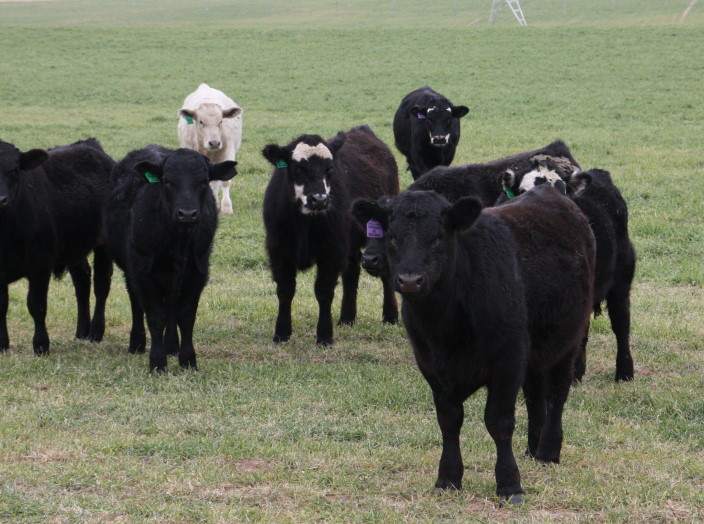
Agricultural News
Forage Marketing Just as Important in Feeder Cattle Marketing
Mon, 18 Jul 2011 09:27:35 CDT
 Whether it's a cow-calf producer selling weaned calves or retaining calves through a stocker or backgrounding program; or a stocker producer adding weight to lightweight calves, the market value of feeder cattle at various weights reflects the value of forage used in the production of feeder cattle. According to Dr. Derrell Peel, OSU Extension Livestock Market Economist, these economic signals are contained in the level of feeder cattle prices and the price relationships between different weights of feeder cattle. Feeder cattle producers are really in the forage business more than in the cattle business.
Whether it's a cow-calf producer selling weaned calves or retaining calves through a stocker or backgrounding program; or a stocker producer adding weight to lightweight calves, the market value of feeder cattle at various weights reflects the value of forage used in the production of feeder cattle. According to Dr. Derrell Peel, OSU Extension Livestock Market Economist, these economic signals are contained in the level of feeder cattle prices and the price relationships between different weights of feeder cattle. Feeder cattle producers are really in the forage business more than in the cattle business.
In most markets, relative prices provide incentives to increase or decrease production. Cattle production has the additional complexity of considerable flexibility in production systems. Cattle can be produced using relatively more or less forage. Thus, cattle markets also must provide incentives for the cattle industry to utilize the best production systems for different market situations. Sometimes the market emphasizes weaned calf production and at other times the market emphasizes heavy feeder cattle production on forage.
Lessons from history can be instructive. 2006 was a good example of a market emphasizing calf production. The major market conditions at that time were cyclically low cattle numbers and cheap corn. The result was high calf prices, similar to current levels, but a sharp decline in prices for heavy feeder cattle. The price of a heavy feeder was less than 80 percent of the price of a calf. Thus, the value of forage marketed through weaned calves was high but the value of stocker or backgrounding gain was relatively low. With cheap corn and low cattle numbers, the market was encouraging cattle to move into feedlots quicker and lighter and the potential for stocker based gains was limited.
The year 1996 was a good example of the other extreme. Cyclically large cattle numbers and drought-induced, high corn prices resulted in low feeder cattle price levels, thus discouraging calf production, but relatively high value of stocker gain that encouraged more forage based feeder production to stretch limited corn supplies. The price of a heavy feeder was approaching 90 percent of the price of the calf price. In this situation, the returns to cow-calf production were low but the returns to stocker or backrounding gains were relatively high. The value of forage was higher when marketed through fewer, but heavier, feeder cattle.
The current market environment can be characterized by low cattle numbers and high corn prices. Such a combination of factors is unprecedented in the history of the modern cattle industry. On the one hand, low cattle numbers implies market incentives to increase cow-calf production-thus high calf prices. One the other hand, high corn prices implies incentives to produce more heavy feeders and reduce corn usage in the feedlot-thus heavy feeder prices that are high relative to calf prices. In Oklahoma last week, the price of a 477 pound, Medium/Large, number 1 steer was $146.06/cwt. and the price of a 769 pound steer was $142.26/cwt. (KO_LS794, USDA-AMS). The result is increased value of forage for all types of cow-calf and stocker production. Cow-calf and stocker producers have more flexibility in production and marketing than at any time in many years. The value of weaned calves is high so a cow-calf focus on maximum cow numbers is consistent with market signals. However, the value of stocker gain is also high so a cow-calf producer interested in retaining ownership of calves through a backgrounding program has considerable potential as well. Stocker producers have considerable flexibility to utilize a wide range of beginning weights, and to hold cattle to heavy weights.
The current situation is unique. Feeder cattle producers don't have to spend a lot of effort to figure out what the market wants you to do. The market wants more of anything using forage. So how do producers decide what to do? Profitability will be determined by cost relative to price for all sizes of feeder cattle. The most profitable choice for each producer will depend on quantity and quality of available resources, management and labor limitations, purchased input needs, and other cost considerations. The main job of producers is to decide how to allocate the resources you control among production alternatives and the biggest resource for most feeder cattle producers is forage. Ask yourself which feasible (for you) production system helps you market your forage to the highest value. It's a good time to be in the forage business.
Our thanks to Dr. Peel for this latest analysis of the beef cattle marketplace- it's a part of the weekly Cow Calf Corner electronic newsletter that Dr. Peel and Dr. Glenn Selk of OSU produce on most Mondays.
WebReadyTM Powered by WireReady® NSI
Top Agricultural News
More Headlines...



















